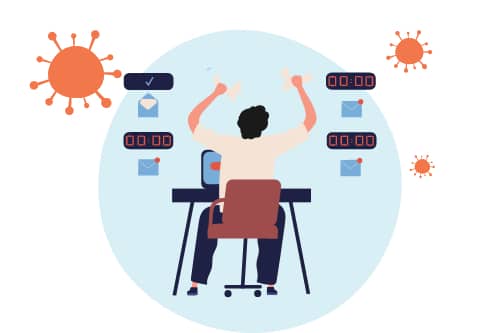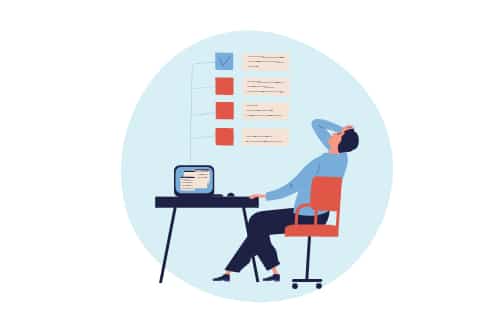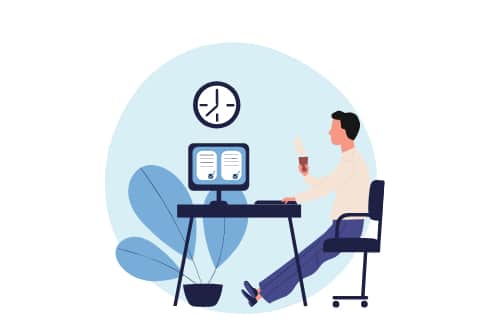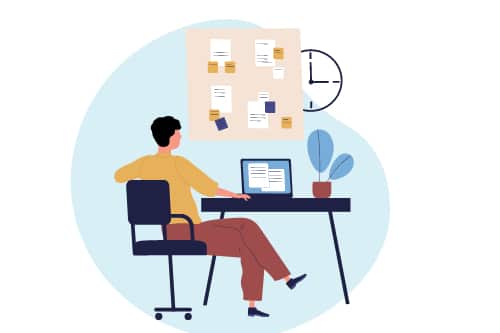How to Manage Work-from-home Burnout?
Summary: Work-from-home has increased the burnout rate amongst working professionals. It has blurred the line between work and home. This has created conflicts, disagreements, and difficulty in managing tasks. Burnout lowers productivity, impacts concentration & memory, and can also affect mental & physical health.
Work-from-home + Pandemic = Burnout
It’s been almost a year since we all shifted to a work-from-home setup. It has been confusing, tiring, and draining. As Esther Perel, therapist and author, rightly says “it’s not work from home, it’s work with home”. This line sheds light on how our work and home have intermingled with each other. We are waking up to piles of dishes, rushing to get the first cup of tea/coffee as we log in for the morning meeting. Between the meetings we are finishing our breakfast, taking care of distractions that may come like kids, parents, or pets. Amidst all this, we find ways to make quick food to survive through the day. Not to forget the never-ending household chores!
Does all this sound relatable to you?
Our lives have changed after this set-up. We are frequently fighting over how much work each one of us has. There are constant clashes at home between partners, parents, and kids. The arguments center on not having space to work, who does what chores at home (or none at all!), who handles kids or pets while the other finishes work or other chores, and there are disagreements on when things should be done and how.
Work-from-home has affected all of us greatly. Going to a workspace allowed the working professional to allocate time and attention only to work. It allowed others who stayed and looked after home some space to finish house-related responsibilities at their own pace without disturbance. The merger of both has created a lack of this distinction. To top it all, we all are in the middle of a pandemic which is not seeming to end anytime soon. This restricts us to our homes, without any chance of breaks.
The second wave brings with itself more pain and grief. We are physically and mentally drained out. With collective grief, loss, and added uncertainty, handling day-to-day activities has become a task. In short, we all are burnout to some degree.
Signs of work-from-home burnout
Work from home has led to an increase in loneliness, lower productivity, feeling of fatigue, and restlessness. Burnout arises when the stress has not been managed or has been going on for a longer duration. The second wave of COVID-19 has made many people shift from a state of stress to weariness. Understanding the signs of work from home burnout can help you manage it better.
- Getting angry and frustrated easily.
- Feeling tired and fatigued even when you have done nothing, causing physical exertion.
- Having less patience than you used to.
- Feeling hopeless and helpless about yourself, work, or life.
- Changes in sleep patterns and appetite.
- Indulging in unhelpful coping strategies like excessive drinking, smoking, or eating.
- Loss of interest in activities or work that you enjoyed earlier.
- Feeling overwhelmed and dreading meetings, zoom calls, or new projects.
Do you find these symptoms relatable? Speak to a therapist for a trial call.
Managing work-from-home burnout
Burnout begins with prolonged stress. Using healthier ways to manage stress can prevent the state of burnout. Work from home burnout can arise not only due to stress but the continuous interplay of roles and responsibilities. The pandemic has mixed our roles and it becomes an exertion to manage all at once. Here are some ways you can manage your burnout:
#1 Set Boundaries
Boundaries are invisible lines drawn out to bifurcate what is acceptable, what works, and what doesn’t. Establish boundaries around your work timings, workspace, and responsibilities. Communicate to your office about your work timings and avoid entertaining work beyond your timing. At home, communicate your availability, meeting schedule, and break timings. This allows others to understand when you have light work and when you need to give undivided attention.
Boundaries are not only for others, but also for self. Make sure you cut-off after your work timings and dedicate that time for home & self.
#2 Relook your tasks
WFH has led to many take upon additional responsibilities either due to layoffs, co-workers being unwell, increased workload, etc. It’s important to communicate the amount of work you can undertake. Having too many tasks can lead to immense stress and may lead to burnout.
#3 Socialise virtually
Yes, after a long day of staring at the screen and with numerous meetings, it can get tiring to connect with others. But it is essential to connect with others other than your coworker or family. Socialization does not only have to be video calls if that is cumbersome. Connect with others via audio, text, or voice note. Schedule a weekly call with your friends. Alternatively, you all can meet for quick online games. This helps in de-stress and building connections.
If you miss the office setting of chai time talks, have alternate days/weekly non-work-related calls with co-workers during your usual tea time.
#4 Hobbies
Spend some time and think about two years ago and the hobbies you wanted to engage in but couldn’t. Plug those hobbies into your schedule. Choose hobbies that are a mix of easy and little challenging. The goal is to not master but to use these hobbies as a cool off for the brain, mind, and body. If you can’t remember any hobby, choose a new one! This is the best time to look at small home improvement projects. Ensure you do it safely.
#5 Self-Care
Engaging in some form of self-care has proven to be effective in dealing with burnout. Self-care activities can be taking out ‘me time’, being assertive, saying no, journaling, mindfulness, having adequate sleep & a nutritious diet, etc. Taking care of yourself is vital as burnout drains you out.
Just like how you put your laptop to charge after the battery dies, you too must recharge yourself when experiencing burnout. Your body is not a machine to be up and running 24/7. You are a human with other needs and wants which go beyond work. Prioritize your daily tasks to manage burnout effectively.
Frequently Asked Questions (FAQs)
A. If unmanaged, work-from-home burnout may cause weariness and fatigue. Early signs of burnout can be physical tiredness, constant aches and pains, etc. It’s important to take care of your physical health and your mental health during burnout.
A. Open communication with your manager can help set up boundaries. Prepare a list of multiple tasks in your hand and how that is becoming difficult for you. If a task cannot be shed or shared, work around a way that gives you enough time to complete it. Working with a mental health professional can help you get better at communication.
A. No. If you learn how to manage stress in healthy ways, you can prevent burnout and fatigue. It is good to track your stress level and work on reducing it through healthy mechanisms.







